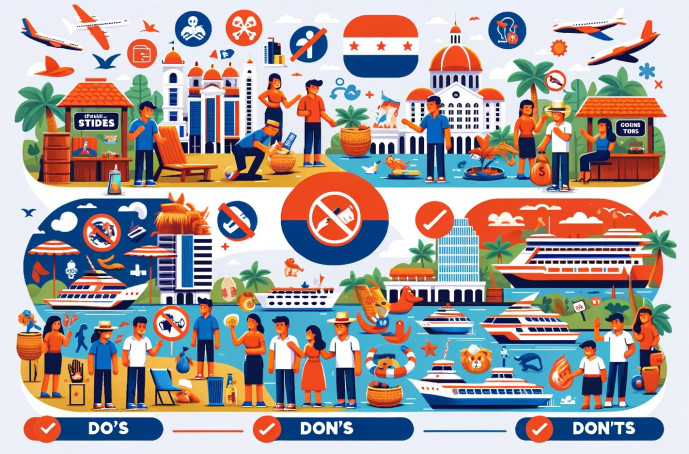Do’s and Don’t in Panama
Master Panama etiquette: Learn key cultural dos and don'ts for a seamless visit.

Essentials
Social Etiquette & Daily Interactions
Greetings and Politeness
- DO: Greet people with a friendly “Buenos días” (good morning), “Buenas tardes” (good afternoon), or “Buenas noches” (good evening/night) when entering shops, elevators, or meeting someone. This is a common courtesy and is expected in daily interactions.
- DO: Use formal titles like Señor (Mr.), Señora (Mrs.), or Señorita (Miss) when addressing people you don’t know, especially elders.
- DON’T: Be overly direct or rush into business. A little small talk before getting to the point is appreciated and considered polite.
Dress Code
- DO: Dress “city-smart” in Panama City. Locals tend to dress well, and you will feel more comfortable fitting in. Long pants and closed-toe shoes are recommended for nicer restaurants and clubs.
- DON’T: Wear beachwear (shorts, tank tops, flip-flops) when visiting government buildings, banks, or upscale establishments. You may be denied entry as a matter of dress code.
- DON’T: Wear any camouflage-patterned clothing. It is illegal for civilians to wear military-style attire in Panama.
Punctuality (“Panamanian Time”)
- DO: Arrive on time for scheduled tours, official appointments, and dinner reservations. Punctuality is expected in these formal settings.
- DON’T: Be surprised if social gatherings start 15-30 minutes later than the stated time. This is common and known as “Panamanian time.” For clarity, formal appointments are punctual, while casual social events are more relaxed.
Health, Safety & Security
Personal Safety
- DO: Be aware of your surroundings, especially in crowded areas like markets, bus terminals, and on public transport to avoid pickpockets.
- DON’T: Flaunt expensive jewelry, large amounts of cash, or high-end electronics. It is wiser to keep valuables out of sight.
- DO: Use ride-sharing apps (like Uber or Didi) or official, registered taxis, which can be identified by their yellow color and unique number plate.
- DON’T: Walk alone at night in unlit or unfamiliar areas, particularly in certain parts of Panama City (e.g., Calidonia, El Chorrillo) and the city of Colón. We advise sticking to well-populated, tourist-friendly areas after dark.
Health & Environment
- DO: Drink bottled or filtered water. While tap water is generally considered safe in Panama City, it’s best to be cautious, especially in rural areas and on the islands.
- DO: Use insect repellent, especially at dawn and dusk, to protect against mosquitoes that can carry Dengue or Zika.
- DON’T: Forget to apply high-SPF sunscreen. The tropical sun is extremely strong, even on overcast days.
- DO: Respect wildlife. Observe animals from a distance and never feed them, as it can disrupt their natural behaviors and diet.
Money, Tipping & Bargaining
Currency & Payments
- DO: Carry small US dollar bills ($1, $5, $10, $20). The US dollar is an official currency, but many smaller shops, vendors, and taxis will not have change for a $50 or $100 bill.
- DON’T: Be surprised to receive change in Panamanian Balboa coins. The Balboa is pegged 1:1 with the USD and exists only as coins, which are used interchangeably with US coins.
Tipping Culture
- DO: Check your bill at restaurants for an included service charge, often listed as servicio or propina.
- DO: Tip 10-15% for good service in restaurants if a service charge is not already included.
- DO: Tip tour guides ($5-$10 per person for a half-day tour) and private drivers as a sign of appreciation for their service.
Bargaining
- DO: Feel free to negotiate politely at artisan markets, such as the Mercado Nacional de Artesanías. A 10-20% discount is often achievable with a friendly approach.
- DON’T: Attempt to bargain in supermarkets, department stores, or upscale boutiques where prices are fixed.
Cultural Sensitivity & Respect
Interacting with Indigenous Communities
- DO: Always ask for permission before taking photographs of people, especially in Guna Yala (San Blas Islands) or Emberá communities. Some individuals may request a small payment ($1-$2). This is a crucial way to show respect for their privacy and culture.
- DO: Support local communities by purchasing authentic handicrafts directly from the artisans.
- DON’T: Treat a visit to an indigenous village like a human zoo. Engage respectfully, listen to their stories, and follow the lead of your guide to ensure a meaningful interaction.
Photography & Drones
- DON’T: Take photos of government buildings, military installations, or police officers, as this is often prohibited.
- DO: Check and respect drone regulations. Flying drones is restricted near the Panama Canal, airports, and in many national parks to protect security and wildlife.
Sensitive Topics
- DO: Refer to indigenous peoples by their specific group name (e.g., Guna, Emberá) rather than using the general term “indios,” which can be considered pejorative.
- DON’T: Bring up sensitive political history, such as the 1989 US invasion, unless a local initiates the conversation and seems comfortable discussing it.